June 21, 1913 was a warm summer day in Hellerau, a small pre-planned garden city to the north of Dresden. As evening fell, the sun began to cast shadows over the community Festshalle, in front of which gathered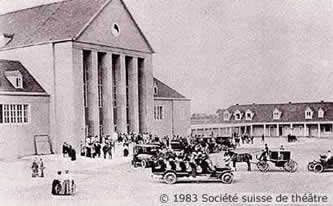 “throngs of people who had journeyed from places all over the earth where art was loved and cherished” (Sinclair 1).1 As they shuffled through the monumental entrance, some of the elegant visitors glanced up at “Dalcroze’s eye”: the comforting yin-yang symbol hung above the portal and was still easily discernable in the half obscurity created by the setting sun (Bie 369).2 The symbol’s flowing, simple black and white curves reminded visitors of the moral goals of the pedagogical province they were entering, and its shared cultural ideals of an organic community based on rhythm, harmony, graciousness, and simplicity.3 Visitors may have slid their hands briefly along the cold, “naked” face of the noble building while passing like toy soldiers through the majestic porticos and into the foyer, where bustling flea market stalls were set up selling the various products of Hellerau’s artists and craftsmen (Giertz 164).4 Glancing perhaps at the goods for sale, they would have eventually wandered on into the vast, rectangular, main hall, where they would have been met by a startling, glowing light.5 Never before had these visitors entered a room like this, which was not artificially lit, but rather acted itself as a lighting body, diffusing light equally in every direction, recreating what seemed like natural daylight.6 Described as “objective, neither cold, nor hot, but rather of a marvelously living consistency … with an imperceptible dynamism” (Appia 206; original),
“throngs of people who had journeyed from places all over the earth where art was loved and cherished” (Sinclair 1).1 As they shuffled through the monumental entrance, some of the elegant visitors glanced up at “Dalcroze’s eye”: the comforting yin-yang symbol hung above the portal and was still easily discernable in the half obscurity created by the setting sun (Bie 369).2 The symbol’s flowing, simple black and white curves reminded visitors of the moral goals of the pedagogical province they were entering, and its shared cultural ideals of an organic community based on rhythm, harmony, graciousness, and simplicity.3 Visitors may have slid their hands briefly along the cold, “naked” face of the noble building while passing like toy soldiers through the majestic porticos and into the foyer, where bustling flea market stalls were set up selling the various products of Hellerau’s artists and craftsmen (Giertz 164).4 Glancing perhaps at the goods for sale, they would have eventually wandered on into the vast, rectangular, main hall, where they would have been met by a startling, glowing light.5 Never before had these visitors entered a room like this, which was not artificially lit, but rather acted itself as a lighting body, diffusing light equally in every direction, recreating what seemed like natural daylight.6 Described as “objective, neither cold, nor hot, but rather of a marvelously living consistency … with an imperceptible dynamism” (Appia 206; original), 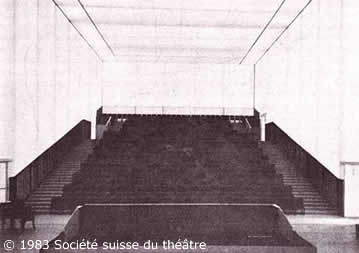 this light created a “milky ambiance” or “elysian atmosphere,” and caused visitors to feel as if the “fresh air of the Greek sky [had been technically transposed] into the northern night” (Appia 212; original). Puzzled by the lack of an elevated stage, and curious as to why the lights were not dimming, the audience moved towards the steep risers arranged at one end of the room “as in a harsh amphitheater, with no balconies or boxes” (Marsop 373; original). The show was about to begin.
this light created a “milky ambiance” or “elysian atmosphere,” and caused visitors to feel as if the “fresh air of the Greek sky [had been technically transposed] into the northern night” (Appia 212; original). Puzzled by the lack of an elevated stage, and curious as to why the lights were not dimming, the audience moved towards the steep risers arranged at one end of the room “as in a harsh amphitheater, with no balconies or boxes” (Marsop 373; original). The show was about to begin.
The illustrious public that made their way to Hellerau on that fateful night in June 1912 had come to see Emile Jaques-Dalcroze’s and Adolphe Appia’s staging of Gluck’s Orpheus und Eurydice. Performed by students of the Dalcroze Bildungsanstalt, this production was created for Hellerau’s second annual fêtes scolaires.7 That evening, the young gymnasts would first display exercises, and then give exterior form to the emotions and ideas contained in the rhythms of Gluck’s music by translating these rhythms into corporeal movement. Their performance realized the dream professed by Wagner and elaborated by Nietzsche: a revival of ancient Greek tragedy in modern times through a synthesis of the arts according to the principle of Greek orchestique.[Jaques-Dalcroze’s interest in Greek orchestique is documented in Dutoit-Carlier 349–50. Jaques-Dalcroze felt that Grétry, Gluck, Wagner, Schiller, and Goethe had all tried in the past to create an “art analogous to Greek orchestique” (“un art analogue à l’orchestique grecque”) (no source, qtd. in Dutoit-Carlier 349). Most contemporaneous writers traced Jaques-Dalcroze’s definition of Greek dance back to Wagner’s commentary in Das Kunstwerk der Zukunft, an excerpt of which was included in the original program for the school festival in Hellerau in 1912. See Die Schulfeste der Bildungsanstalt Jaques-Dalcroze: Programmbuch 33–40.] The production they staged that night represents one of the first significant attempts in the twentieth century to create a dramatic stage work by visualizing music through bodily movement. Jaques-Dalcroze called this union of music and movement plastique animée. He revealed his understanding of this practice through the plot of Gluck’s opera, focusing upon the relationship between Orpheus, the mythical musician, and Eurydice, whom Jacques-Dalcroze stylized into an embodiment of the principle of human movement. Drawing upon recognizable bodily images with broad cultural significance for his time, Jaques-Dalcroze told the story of Orpheus und Eurydice as an attempt to transcend the limitations of their own performative activities in order to serve a musical idea, thereby fulfilling the fundamental requirement of plastique animée. Whereas Eurydice experienced an Apollonian transformation in which her dancing body dissolved into pure light, Orpheus the musician failed to transcend, remaining fixed in an unhealthy, static state linked visually in the opera to Freud’s theory of sexual repression. Orpheus and Eurydice could not unite because her death and absence were necessary aesthetic criteria for plastique animée. The failure of their love opened up a conflict of emotion and form that was to haunt twentieth–century neoclassicism.
Emile Jaques-Dalcroze and Adolphe Appia carefully chose Hellerau as the location for their theatrical and social project. Conceived within the spirit of social reform that inspired the nineteenth–century English garden city and motivated the German Gartenstadtbewegung, Hellerau was the brain child of Karl Schmitt, one of the co-founders (with Frederic Nauman) of the German Werkbund. In 1907, Schmitt decided to build a factory outside of Dresden for the 1200 workers of his Dresdener Werkstätte für Handwerkkunst or Deutsche Werkstätte, which produced furniture and utensils of a simple, beautifully crafted, yet functional style. Concerned with the overcrowded, cramped, and dirty living conditions for workers in most major German cities, Schmitt planned to rent to his own workers affordable family homes with gardens in a green and calm surrounding. He designed Hellerau as a community that would solve social, economic, cultural, and artistic problems, and function as a unified whole; Schmitt thus planned stores, post offices, schools, a sanatorium, villas, and playgrounds.8 The architect Richard Riemerschmidt placed great emphasis on creating an aesthetically pleasing living space and consequently designed the entire city in a unified architectural style in order visually symbolize its communal ideal (Arnold 329–52).9 Like the everyday objects produced in its factories, the simple, proportional buildings in Hellerau encouraged “new life discipline and manners” by being both functional and beautiful at the same time (Arnold 334–5; original).
From the beginning, Karl Schmitt and his associates planned Hellerau as more than just another nice place to live. They believed that its residents would be able to profit both morally and physically from their carefully planned, organic environment by involving themselves in communal cultural activity.10 To this end, Schmitt’s close friend Wolfgang Dohrn, the general secretary of the Werkbund, envisioned the construction of a central house, a symbol for the whole community:
… a house, not for singles or familes to live in, but rather for all, not for learning and becoming more intelligent, but rather for enjoyment, not for praying according to some religious denomination, but rather for Andacht and inner experience. What I mean is, neither a school, museum, church, concert hall or auditorium! Something of all of these, but also something else too! (Dohrn 27–8; original)
Volksheime or maisons du peuple existed all over Europe at the turn of the century, especially in Belgium, as central communal buildings that housed organized programs designed to ensure the workers’ well-being. Heinrich Tessenow designed the Volksheim in Hellerau as more of a Wagnerian Festspielhaus, but in the style of primitive classicism. Built in 1911–12 for a sum of 1,450,000 Marks, Tessenow’s Festspielhaus dominated the entire community, its severe doric columns exuding an Apollonian spirit that set the tone for the events staged within its walls (Arnold 353). Its stark, archaic functionalism even sparked debate and controversy in the German architectural community and inspired the young Charles-Edouard Jeanneret (Le Corbusier). Tessenow’s building met with the most effusive praise from the artists for whom it was designed. Wolfgang Dohrn invited Emile Jaques-Dalcroze and Adolphe Appia to Hellerau in the fall of 1910 in order to establish a school of rhythmic gymnastics; both men consequently played an active part in the Festspielhaus’s design. In a letter to Wolfgang Dohrn, Jaques-Dalcroze marveled at how Tessenow so aptly realized the social vision inherent in their music pedagogical project: “In their simplicity and harmony the style of [Tessenow’s] buildings match perfectly the style of rhythmic movement of the body. This is very important for this particular genre of staging” (Appia 97; original). In a separate letter to Jaques-Dalcroze, Appia agreed: Tessonow had perfectly understood that “the architecture of the [main] building had to disappear behind the activity you [Jaques-Dalcroze] wanted to give birth to there” (97; original).
Jaques-Dalcroze opened his Bildungsanstalt in Hellerau in the fall of 1911, working at first in temporary quarters in Dresden before moving into Tessenow’s completed building in the fall of 1912. With missionary zeal, he set about realizing his project: creating “organic life,” and “harmonizing the country and its inhabitants with a special education” based on “physical and moral hygiene,” thereby “elevating rhythm to the level of a social institution” (Appia 96–7; original). In the spirit of Hellerau, Jaques-Dalcroze offered the workers’ children free lessons in the Bildungsanstalt and opened its doors to an international roster of students. The curriculum rested on the three pillars of solfège, improvisation, and gymnastique rythmique, (eurythmics or rhythmic gymnastics), and included no instrumental instruction.11 This was more than a mere music school, however. In his pedagogical program, Jaques-Dalcroze hoped to educate through music the new people who would populate the ideally functioning society of Hellerau. Following in Goethe’s and Nietzsche’s spirits, his supporters envisioned that his school would be the first step in “founding the state upon music” (Seidl 16; original).
The yearly activities of the Bildungsanstalt in Hellerau culminated in annual “fêtes d’école” or “fêtes scolaires,” in which Jaques-Dalcroze displayed the results of his music pedagogical program. His supporters viewed these events as a modern day counterpart to the folk festivals and games of ancient Greece, as occasions during which the audience participated in a form of public confession:
Everybody that comes must let themselves become imbued with the rhythmic experiences, must inwardly process them in the elevated atmosphere of festive bonding …. Everybody who comes must see what is performed as something they have experienced themselves, they must accept the bodies they see as a symbolization of their own spiritual processes, the images before them as an expression of their own thoughts and desires. In this manner, everybody will contribute to the success of the festival and serve in the right manner the work that has begun. (Horneffer 14; original)
Jaques-Dalcroze hoped these events would inspire “a sense of solidarity that will reinforce reciprocal artistic desires between the students and the spectators” (Appia 114; original). With Adolphe Appia, Jaques-Dalcroze believed the public should become “a true collaborator of the symbolic and poetic spectacles,” thereby increasing their aesthetic sensibilities and artistic sense (Jacques-Dalcroze, Le Rythme 94; original). Supporters of Hellerau believed that Jaques-Dalcroze’s festival could even supersede Wagner’s Bayreuth in its effectiveness because it concentrated upon simple, natural, easily understandable art for the people (Seidl 16–17). Two hundred and fifty people attended the first fêtes from 28 June to 11 July 1912, which included class demonstrations of rhythmic exercises, Jaques-Dalcroze’s pantomime Echo et Narcisse, a visualization of Mendelssohn’s Prelude and Fugue in E Minor, Bach’s Invention and Fugue in C Minor from Das Wohltemperierte Klavier, and the opening scene of Act II from Gluck’s Orpheus. Even more visitors made the pilgrimage to Hellerau for the second annual festival from 21 to 28 June 1913, in which 400 students performed exercises, and which also included the complete staging of Orpheus und Eurydice.
Gluck’s neoclassicist Orpheus und Eurydice provided an ideal framework for Jaques-Dalcroze’s and Adolphe Appia’s spiritual revolution. Although Gluck’s works had not been performed regularly in Germany, the bicentennial in 1914 would change all that: Hermann Abert founded the Gluck-Jahrbuch and Gluck Gesellschaft, and even published the original 1764 score of the Viennese Orpheus und Eurydice in the Denkmäler der Tonkunst in Österreich, resulting in a flurry of productions across Europe.12 Perhaps the greatest impetus for the Gluck revival came not from musicology or state-sponsored celebrations, however, but from modern dance. It is not a coincidence that Isadora Duncan worked on Gluck’s operas for over fifteen years of her life (from 1900 to 1915), always returning to revise them and broaden their scope. She finally presented Orpheus und Eurydice as a drama-music-dance with chorus and vocal soloist during her month-long Dionysion season at the Century Opera House in New York, April 1915 (Daly 146–50). Composed within the context of the eighteenth–century dance reforms of Noverre and Angiolini (each of whom collaborated with Gluck), these operas not only contained extensive sections suitable for dance, but also embodied the classicist aesthetic admired by both Duncan and Jaques-Dalcroze. Angiolini’s reforms even attracted some musicological attention in 1913, especially after the discovery of the score to Don Juan in Vienna’s Hofbibliothek.13
Many critics, including Karl Storck, welcomed Jaques-Dalcroze’s attention to Gluck’s music, because as “form moved by tones” (“tönend bewegte Form” in Edward Hanslick’s sense), Gluck’s music resulted from the inner movements of its parts and was thus ideally suited for “plastic embodiment.” By choosing such music, Jaques-Dalcroze avoided the error committed by Isadora Duncan and others: that of dancing to program music, Ausdrucksmusik, or music that suggests inner psychological or spiritual worlds that can not be realized visually or translated physically in movement (Storck 29–30).14 As an aristocrat who avoided any “concession to the taste of the masses,” Gluck could also serve as a moral authority in the present, according to Hermann Abert and other Gluck scholars (Abert, “Zum Geleit” 2; original). Gluck’s “pure” music had the capacity to educate the masses and draw them away from their degenerate interest in “effortless pleasure” and “feeling” (Abert, “Zum Geleit” 1, 3; original).
In the highly nationalistic pre-War period, the resurgence of interest in Gluck’s Orpheus brought with it—not surprisingly—intense debates over the relative merits of the opera’s original Viennese and later Parisian versions. By the late nineteenth century, neither of these versions survived in the repertory; in their place emerged a variety of hybrid mixtures, most of which were influenced by Berlioz’s well-known amalgamation from 1866.15 In November 1913, however, Hermann Abert organized a performance of Orpheus in Lauchstadt based on his publication of the original Viennese score, designating Orpheus as a baritone for the first time in modern German operatic history. This historically informed production used Gluck’s original orchestration, a cembalo basso continuo, and historical sets evoking eighteenth–century tastes (Niedecken-Gebhard 296–7). Abert’s Viennese Orpheus, following in the wake of Hellerau, brought into focus a critical evaluation of the first two versions, especially in terms of their varying uses of dance—the elaborated feature of the Parisian score that most twentieth–century critics (whether in 1913 or 1999) reject as a sign of Gluck’s embarrassing concession to popular French taste. The emotions raised by the debate reflected deep anxieties about how the work was to function in the construction of national cultural identity. Whereas critics could easily align the Viennese Orpheus with a Wagnerian operatic aesthetic and thus justify Gluck’s place in the German pantheon, they could not do so with the Parisian version, and thus felt awkward about this work, which used music theatrically in a manner long considered foreign to German tastes.
Jaques-Dalcroze concerned himself little with the authenticity or historical accuracy of his production of Gluck’s Orpheus in Hellerau, much to the disappointment of his critics. Departing from the standard Peters edition of the opera available at the time, he modified form, instrumentation, and performance practice at will, even further downplaying the importance of Gluck’s music by concentrating almost exclusively on its staging, to the detriment of the actual musical performance. His decision to stage the work in the first place hardly resulted from extended critical reflection on its history, but rather from something like a whim. Appalled by productions in Mézière and St. Petersburg, Jaques-Dalcroze decided to direct the opera himself so that the staging, lighting, and movement would better realize visually the rhythms of Gluck’s music (Stadler 440).16 By placing the large portion of the choir and singers behind the scene and having his gymnasts perform their plastique animée in front of curtains flooded with expressive light, Jaques-Dalcroze hoped to recreate the conditions and experience of Greek orchestique as the basis of tragedy. His production and modification of Gluck’s score highlighted bodily movement even further, not only by emphasizing specific dance numbers within the opera, but also by remodeling the story in order to shift his audiences’s attention away from the sonoric beauty of Orpheus’s song to the visual expressiveness and spiritual transcendence of Eurydice’s dance.
Although much has been written about Orpheus’s mythical status as a musician, very little has been said about Eurydice’s dance, even though her physicality, presence, and movement lie at the very root of the Orpheus story. From the moment she is first described in Virgil’s Georgica and Ovid’s Metamorphoses as running with the other nymphs, Eurydice is in constant movement, experiencing life in an expressively sensual and physical fashion. She has very little memory, an undefined history, and difficulty in feeling the complex emotions required for her to grasp abstract concepts. She seems to remember Orpheus only when she sees him—for example, at the moment when he returns to hell to retrieve her (Krieger 53). The story of the opera seems predicated not on her ability to engage in conversation, but rather on her talent to move in a manner that attracts Orpheus’s gaze. Calzibigi accentuated this historical aspect of Eurydice’s character in the libretto he wrote for Gluck in 1764. Gluck then translated Eurydice’s physicality into musical terms by giving her more dance music (an aspect of the opera that he later emphasized in its later Parisian version). In their production in Hellerau, Jaques-Dalcroze and Appia modified Gluck’s Orpheus even further, emphasizing the role of Eurydice’s dance by casting a student gymnast as Eurydice instead of a professional singer. By shifting attention away from the listening experience of the music towards its visualization, Jaques-Dalcroze and Appia allowed Eurydice’s transcendent movement to replace Orpheus’s song as the focus of the opera’s aesthetic interest.
Eurydice’s dancing body makes its presence felt from the very opening bars of Jaques-Dalcroze’s Orpheus, particularly throughout the chorus of lamenting nymphs in Act I. Stunned by the jolting omission of the overture, the audience would have immediately heard the strains of this first chorus, and then seen four groups of nymphs entering from both sides of the hall, moving in front of Appia’s broad set of nine stairs constructed of large wooden blocks.17 The swerves of their flowing Duncanesque robes gracefully reflected the phrasing of the music as they moved towards Orpheus, the famous contralto Emmi Leisner of the Berliner Staatsoper, who sat bent over in front of a singular wooden block symbolizing Eurydice’s tomb.18
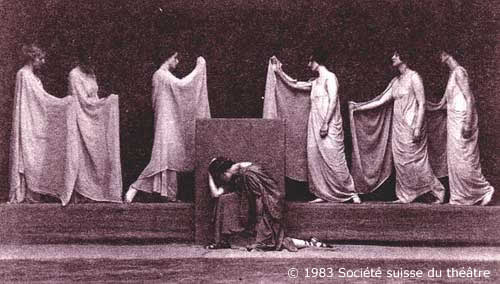
The nymphs were not dancing for the sake of sheer operatic spectacle; rather, they exteriorized, and thus made suitable for the theater, Orpheus’s grieving memory of Eurydice. By transforming Orpheus’s grief into recognizable visual and gestural images of Eurydice, the nymphs gave to dance the aesthetically viable dramatic function Isadora Duncan had reserved for it in her earlier choral interpretations of Gluck’s work.19 Orpheus is so absorbed in his thoughts of Eurydice, that his feelings can only embody her, and so she comes alive through the elegiac movements of the fantastically classicized nymphs who move to the rhythm of her name.
The mourning nymphs express Eurydice’s noble character through their slow, simple, and gracefully classical walk. This walk was not only the fundamental activity in Jaques-Dalcroze’s method, but also, according to Maurice Emmanuel, the basis of Greek orchestique.20 In his treatise, La danse grecque antique of 1895, Emmanuel attempted to reconstruct Greek dance by piecing together the movements he found depicted on vases and reliefs. Emannuel thereby brought back into cultural consciousness classical Greek images which subsequently exerted considerable influence on the development of modern dance.
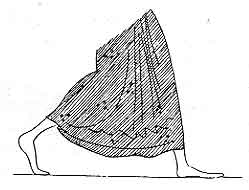
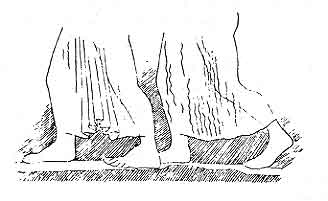
The walk seen here in video example 1 is described by Emannuel: the dancer transfers weight from the arched back ankle to the flat front foot, propelling her movement forward as characteristic of Greek dance after the sixth century B.C. (link to video example 1) The nymphs periodically stop to form tableaux vivantes of human grief, using bodily images that Jaques-Dalcroze may well have borrowed from Emmanuel’s chapter on “funeral dances.”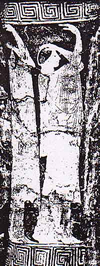 Emmanuel described how dancers or “pleureuses” originally sang while walking in rhythmic unison, ripping their hair, beating their chests, tearing their clothes, and scratching their faces, all while accompanied by a solo flute. With time, they replaced these violent actions with more simply figured, symbolic gestures (or what Emmanuel calls “simulacre”), such as the one used by Dalcroze’s first and third mourners (from left to right) as seen in the picture below. Dalcroze’s fourth mourner is likewise symbolically beating her chest—a second Pathosformel of human grief.
Emmanuel described how dancers or “pleureuses” originally sang while walking in rhythmic unison, ripping their hair, beating their chests, tearing their clothes, and scratching their faces, all while accompanied by a solo flute. With time, they replaced these violent actions with more simply figured, symbolic gestures (or what Emmanuel calls “simulacre”), such as the one used by Dalcroze’s first and third mourners (from left to right) as seen in the picture below. Dalcroze’s fourth mourner is likewise symbolically beating her chest—a second Pathosformel of human grief. 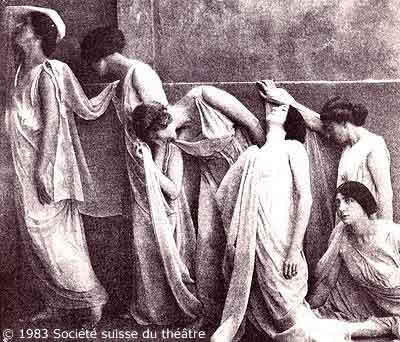 The Eurydice they portray exudes the same spirit of balance and noble simplicity that Jaques-Dalcroze associated throughout the opera with a harmonious society built on organic values and healthy cooperation. By bringing Eurydice to life through this classical Greek image of walking grace, Jaques-Dalcroze communicates in no uncertain terms that he has rooted his plastique animée not in Nietzschean pessimism, or Schopenhauer’s will, or Dionysian ecstasy, but rather in the Apollonian essence of Schiller’s classicist dictate that “music in its highest ennoblement must become form” (Appia 65).21
The Eurydice they portray exudes the same spirit of balance and noble simplicity that Jaques-Dalcroze associated throughout the opera with a harmonious society built on organic values and healthy cooperation. By bringing Eurydice to life through this classical Greek image of walking grace, Jaques-Dalcroze communicates in no uncertain terms that he has rooted his plastique animée not in Nietzschean pessimism, or Schopenhauer’s will, or Dionysian ecstasy, but rather in the Apollonian essence of Schiller’s classicist dictate that “music in its highest ennoblement must become form” (Appia 65).21
Jaques-Dalcroze’s mourning nymphs do not walk naturally on stage to Gluck’s music; rather, they tremble with the music’s emotional essence as expressed through multiple, trained, harmonized movements executed by their entire bodies. Their actions resemble that of a conductor, whose gestural visualizations of music allow an orchestra to understand corporeally the emotional meaning of a piece of music (Jaques-Dalcroze, Le Rythme 42). Jaques-Dalcroze felt that plastique animée worked best with irregular metrical patterns, because these patterns resulted from, and thus better expressed, human emotions.22 dances, and we realize how much more expressive the body is than words, even when they are sung.” (“elle danse, et l’on se rend compte alors combien le corps est plus expressif que la parole, même chantée … ”) (qtd. in Berchtold 81). Jaques-Dalcroze’s contemporaries likewise associated Strauss’s operas (especially Feuersnot, Salome, and Elektra) with a new sensibility that would lead to the physical expression of music (Riesenfeld 472, and Marsop 382–85).] He also encouraged his students to respond to spontaneous decisions made in performance. In Hellerau, dancers tested their skill in plastique animée by reacting in performance to the subtleties of Emmi Leisner’s (Orpheus’s) striking rubato. (link to listening example 1)23 Jaques-Dalcroze did not find in Gluck’s opera the irregular meters he later so admired in Stravinsky’s music; yet he did discover a metric play interesting enough to serve as a model example of plastique animée (Le Rythme 79–80).24 He considered this first chorus to be the easiest number in the opera to translate into gestural movement. This may bave been due to the manner in which Gluck played with accents in the opening, two-bar motivic rhythm (mm. 1–2), and how this rhythmic manipulation related to Orpheus’s grief over Eurydice.25 From the beginning of the opera, the main motive’s emphasized second beat (m. 1) vies for attention with the metrical downbeat, which is itself emphasized in mm. 2 and 4 with suspensions (over VII6 and V6 chords respectively). By the time the nymphs enter (m. 15), however, they have diminished the effect of this accent by stressing the downbeat in the motive’s second bar with a longer suspension (a gesture reinforced by a sf mark in the score). In m. 17 they then omit the offbeat accent entirely. When the nymphs first utter Eurydice’s name (m. 19), they return in a striking fashion to the offbeat accent by starting the phrase on the second beat of the bar. Gluck shifts the nature of the metrical accent on the first beat of the next bar (m. 20) by allowing the VII chord to sit for two beats, rather than giving it the quarter-note length it had in the comparable spot in m. 6.
Jaques-Dalcroze’s method would have taught the nymphs to react to this subtle rhythmic shift immediately, reflecting the unsettling outbreak of emotion in Gluck’s music. Orpheus’s exclamation of Eurydice’s name after the cadence on the dominant (m. 25) further derails the motive by sitting on the third beat of the bar (on “di–” of Eury-di-ce), and by shifting mode dramatically at that same moment. Accompanying Orpheus’s exclamation of grief, a choir of unison sopranos sing the original motivic rhythm. The choir begins to divide, if only briefly, as if to spell out the conflict between the first and second downbeats accentuated by Orpheus’s plea. In m. 37, Orpheus’s outburst so dramatically contrasts the cadence and regularized meter of the choir that they do indeed seem capable of waking Eurydice from the dead, as they are intended to do. With his pleas, Orpheus ultimately ultimately seems to convince the choir (or vice versa) and the two cadence together in mm. 44–48: “The Dead cannot be brought back to life, but the grieving are swept away. And so begins the enchantment of the audience” (Kaufmann 155; original). (link to listening example 2)
As they aid in Orpheus’s expression of grief, the languorous movements and free, unfettered flowing robes of Jaques-Dalcroze’s nymphs give their bodies the appearance of being natural, unrestrained by corsets, manners, and the technological advances of modern society. Ann Daly has shown in the case of Isadora Duncan, that this natural body, “far from being a tabula rasa, beyond the contingencies of culture and history, …was an artistic invention as well as a rhetorical strategy—a conceptual cipher for an ideal of harmony that embraced the Greeks and rejected ‘African savages’” (89). Jaques-Dalcroze’s nymphs did not express their “natural” inner feelings through personal gestures or revive the “natural” Greek subject; instead, they constructed an image of stylized naturalness on the basis of rigorous, relentless training that taught them to tame and control the deviant and unruly energies of their young bodies. Their muscles had been disciplined individually and in combination in “all the nuances of energy and flexibility, in speed and slowness, in order to assure integral functioning and perfect health to each part of the muscular system” (Appia 8, 10; original). They practiced long and hard in order to become “musical resonators that were so vibrant and faithful that they could transpose into attitudes and spontaneous gestures all the aesthetic emotions provoked by the musical rhythms”—all the while achieving an impression “of naturalness and ease” (Appia 10–12; original).
At first glance, the nymphs’ practiced gestures appear to be symbolic—an impression encouraged by the deceiving photographs of the Hellerau Orpheus, which fix the nymphs in posed, postcard-like, statuesque formations. Indeed, such “statue posing” enjoyed great interest in the early twentieth century, especially as a popularized and “falsified” version of François Del Sarte’s American teachings. The French teacher of acting, singing, and aesthetics, Del Sarte developed a system of expression in the mid 1800s that continued to influence French artists and musicians throughout the late nineteenth century, and even became a broad-based social phenomenon when transplanted to the United States at that time (see Ruyter). As Ted Shawn remembered, these teachings consisted of “amateur entertainers, costumed in bulky, graceless ‘Greek’ robes, whitened skin, and white wigs, [taking] ‘poses’ supposedly expressive of grief, joy, shyness, anger, defiance, etc. etc. etc. ad infinitum, ad nauseam” (11).26 In contrast, Jaques-Dalcroze’s nymphs visualized the dynamic flow of the music by remaining in constant movement. Their gestures were not symbolic, but expressive, derived not from watered down Delsartian traditions, but rather from the original writings of Del Sarte himself, copies of which Jaques-Dalcroze possessed in his library.27 From Del Sarte and others, Jaques-Dalcroze developed the idea that bodily gesture functioned expressively and not symbolically, communicating emotions or spiritual ideals much more powerfully than words, sounds, or vocal tone. In the words of an American Delsartian Edward B. Warman:
“Gesture has been given to man to reveal what speech is powerless to express. The gesture, then, like a ray of light, can reflect all that passes in the soul. Hence if we desire that a thing shall be always remembered we must not say it in words; we must let it be divined by gesture … Gestures are [sic] the sense of the heart … Tone [the sounds or tone of voice] expresses bodily conditions and sensations, physical pleasures and pains. Words are arbitrary mental symbols and interpret thoughts and ideas—they describe, label and limit. But gestures relate us to other beings, expressing our emotions, from the highest to the lowest, from spiritual joy to hate, lust and greed.” (Shawn 58)
Jaques-Dalcroze’s understanding of bodily gesture rested firmly on Del Sarte’s much quoted “law of correspondence,” which stated that “to each spiritual function responds a function of the body; to each grand function of the body corresponds a spiritual act” (qtd. in Jaques-Dalcroze, Méthode 1).
Defining transcendental ideas or spirituality as the source of gestural expression distinguished modern dance from ballet, and characterized the work of Isadora Duncan in particular. Like Duncan, Jaques-Dalcroze located the “spirit” in the emotional content of music, or in something equivalent to a musical or poetic idea. Duncan believed in the existence of an actual physical, originating point of spirituality in the body—namely the solar plexus; this “temporal home of the soul” could understand and realize movement corresponding to musical ideas (Daly 137–38). Jaques-Dalcroze, however, thought this spirituality resided in the music, and could only be perceived and realized by human beings who had perfected their aural and gestural abilities. By refining the ability of their entire organism (l’organisme tout entier) to respond to music through movement, Jaques-Dalcroze’s students developed a sensibility that allowed them to establish “an interior state of consciousness and emotiveness” (“un état intérieur de conscience et d’émotivité”) that perfectly coincided with the musical idea (Jaques-Dalcroze, Le Rythme 6, 46–7). As soon as their bodies could respond intuitively to the music, they would feel inside of themselves “a mysterious music that was the direct product of their feelings and sensations” and which Jaques-Dalcroze called “a music of personality,” or later, “an interior attitude” (Dutoit-Carlier 317; original). Jaques-Dalcroze defined the role of the attitude interior in terms of classical expression theory: a feeling inspired by a musical idea and expressible through dance (Franko 75–7). In Nietzsche’s sense, Jaques-Dalcroze would have defined himself as a lyricist, one who understood in music the appearance of the will, and expressed its unspeakable utterings in the Apollonian visual language of plastique animée.
Jaques-Dalcroze’s theory of expression not only countered and redefined common sense notions of human subjectivity, but also ushered in an easily misread modernist notion of impersonality. By situating emotion in the body and defining its relationship to music as unmediated, he seemed to minimize the role of personal reflection in human expression, thereby rejecting the central means by which human beings constitute themselves as subjects. He limited his students’ personal agency by demanding from them “a corporeal state of absolute submission to the rhythm being realized;” this created an atmosphere in which many of his audience members felt subjugated as well (Appia 7; original). Without individually reflected emotional reactions, his students risked becoming impersonal, objectified vehicles for musical ideas requiring stylized bodily representations. Jaques-Dalcroze accentuated his students’ loss of personal agency by training them to understand space through the use of stairs designed by Appia, thus instilling in them the sense that their movement did not originate in their own bodies, but rather plastically related to an objectified space around them.28 Appia further aided Jaques-Dalcroze in transforming individual subjects into objects by designing a system to light dancers only in contrast to their stage surroundings, not on their own terms (Appia 101). The final step in Jaques-Dalcroze’s depersonalization of his subjects occurred when he grouped them in choral formations. Jaques-Dalcroze felt that these formations provided the key to expressing communal sentiment necessary for the new society he envisioned (Le Rythme 8). In such groups, it was necessary that individual gestures “became stylized, and that the movements of chorists renounce their personality in order to subordinate themselves to the ensemble” (Jaques-Dalcroze, Le Rythme 116; original). Stylized movements of the choir become the focal point of Orpheus, to the almost complete neglect of individual gesture.
If plastique animée had merely replaced subjective expression with depersonalized, objective responses to music, it would hardly have touched its contemporaries and motivated modern dancers in the manner in which it did. Its effect was so powerful precisely because it created an unsettling ambiguity about the nature of automization and its consequences for human spiritual development. On the one hand, Jaques-Dalcroze’s method seemed to issue directly from late nineteenth–century studies of human and animal mechanisms and psychological automization initiated by Etienne-Jules Marey, Edward Muybridge, and (in Geneva) Pierre Janet. These studies suggested the possibility of scientifically dissecting and defining every aspect of human gesture with the aim of creating a grammar of human movement with the depth and aesthetic potential of human speech or music. The physician at Hellerau, Dr. Weber-Bauler, thought that Jaques-Dalcroze’s method directly related to the psychological automatisms of Pierre Janet. In 1924, Weber-Bauler suggested that the automisation of human movement best be understood in terms of a “law of economic movement” (“loi d’économie”) that gives the least in order to obtain the greatest result.29 Jaques-Dalcroze himself never allowed this automization to take the upper hand, always insisting that its ultimate purpose was the release of joy, a feeling of spiritual fulfillment, or the development of personality (Le Rythme 97). His method remained unclear about how mechanization related to the attainment of transcendental truth—an uncertainty reflected in Jaques-Dalcroze’s vague, shifting notion of what constituted musical rhythm. Whereas he frequently defined rhythm as meter, thus emphasizing its measurability and easy translation into mechanized human movement, Jaques-Dalcroze at other times equated rhythm more with an inner pulse or free rhythmic flow, something which could not be measured or translated scientifically. This inherent contradiction in his method between mechanized movement and metric rhythm, as opposed to free psychological time and spiritual essence, was not lost on his audiences. Their conflicting reactions to his work reflected their own uncertainty about how to appreciate aesthetically human movement in time.
By sculpting their movements in order to express a transcendental musical idea, Jaques-Dalcroze’s choir of nymphs gave their performance a spiritual dimension that distinguished them from what many people in 1913 understood to be the dry, mechanical exercises of traditional gymnastics or Turnen (Marsop 364). Their state of half relaxation, or what Jaques-Dalcroze called “detente,” realized itself in luxuriously slow movements that allowed the dancers to gather their creative energies.30 Jaques-Dalcroze believed the spirituality they exuded resulted from the improved communication between the brain and body, brought on by the physical training of rhythmic gymnastics and the resulting perfected sensibility. As the muscles learned to resonate more perfectly with the music, dancers physically realized rhythms analyzed by the brain more rapidly, thereby increasing the functional capacity of the brain. In this manner, the body learned to communicate with the brain, thereby ceasing to obstruct its thoughts and allowing for a full flowering of the soul, the “necessary” spiritualization of the human body and music.
Through their gentle walk, the nymphs of Act I make us aware that Orpheus is remembering Eurydice not as a woman, but rather as a classically stylized embodiment of feminine grace. The psychological trauma that could cause a fixation upon a classicist vision of women serves as the focal point of Wilhelm Jensen’s short story Gradiva, 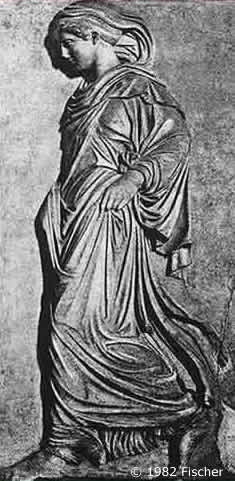 which in turn was the focus of Sigmund Freud’s first literary analysis in 1907. Jensen describes a young archeologist named Norbert who is in love with the classical walk of a young woman he names Gradiva; this woman he finds depicted on an ancient Roman copy of a Greek relief associated with Pompei. Jensen’s Gradiva walks dynamically forward with the very raised back foot characteristic of Eurydice’s Apollonian grace. Norbert becomes aware of his long suppressed desire for a childhood friend through a series of dreams and through his study of Gradiva’s Greek walk. This walk turns out to be his lost friend’s walk, transformed into a safe, archeological, classicized, stone form—the symbol for Freud of Norbert’s sexual repression. The woman he once loved recognizes his trauma and follows Norbert to Pompei, transforming herself into a living Gradiva and walking in front of him in order to break through his insanity and lead him back to a healthy erotic life.
which in turn was the focus of Sigmund Freud’s first literary analysis in 1907. Jensen describes a young archeologist named Norbert who is in love with the classical walk of a young woman he names Gradiva; this woman he finds depicted on an ancient Roman copy of a Greek relief associated with Pompei. Jensen’s Gradiva walks dynamically forward with the very raised back foot characteristic of Eurydice’s Apollonian grace. Norbert becomes aware of his long suppressed desire for a childhood friend through a series of dreams and through his study of Gradiva’s Greek walk. This walk turns out to be his lost friend’s walk, transformed into a safe, archeological, classicized, stone form—the symbol for Freud of Norbert’s sexual repression. The woman he once loved recognizes his trauma and follows Norbert to Pompei, transforming herself into a living Gradiva and walking in front of him in order to break through his insanity and lead him back to a healthy erotic life.
Enveloped in a dreamy blue light,31 overwhelmed by the disembodied sound of choral singing from behind the curtain, Jaques-Dalcroze’s Orpheus seems to be inhabiting the same dream world as Jensen’s archaeologist, haunted by a similar archaeological manifestation of his own sexual repression. He dreams in Act I of an Apollonian Eurydice, whose beautifully arched ankle not only symbolizes her classical perfection, but also the impossibility of that ideal—she is in hell after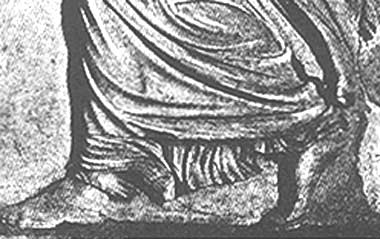 all because she was bitten by a snake and thus brought to her death. Like Jensen’s archeologist, Jaques-Dalcroze’s Orpheus will attempt to face the emotions hiding beneath his nostalgic fixation on an archaic image. He will experience in Act II a terrifying visual nightmare, leading him to a direct confrontation with Eurydice herself.
all because she was bitten by a snake and thus brought to her death. Like Jensen’s archeologist, Jaques-Dalcroze’s Orpheus will attempt to face the emotions hiding beneath his nostalgic fixation on an archaic image. He will experience in Act II a terrifying visual nightmare, leading him to a direct confrontation with Eurydice herself.
Before he finds Eurydice, however, he must confront Amor—a character that never physically appeared on Appia’s stage at all. Amor’s voice, though, was heard “like a promise” from behind the stage as Eurydice’s tomb opened, revealing a brilliant light from another world (Ernst Ansermet, qtd. in Appia 122). Inspired by Rudolf Steiner and Gurdijieff, the lighting technician for the show, Alexandre Salzmann, imbued Amor’s light with moral and spiritual significance. Martin Buber described the space created by this light as “unnamable”: “It is shaped by a principle whose name we do not yet know and of which we know only a symbol drawn from the senses: creative light” (Martin Buber 82). From Jaques-Dalcroze’s Amor, Apollo passes on to Orpheus the clarifying light of reason, which he then takes with him to fight the furies in the underworld.
In Jaques-Dalroze’s production of Orpheus’s famous second act, Emmi Leisner (as Orpheus) enters the dream of Hades by descending Appia’s long dramatic flight of stairs. She is accompanied not by Orpheus’s famous lyre, but rather by a powerful light that increases in brilliance as she moves downwards, symbolizing Orpheus’s role as an enlightened artist and Apollonian hero who brings with him reason, music, and the word.32 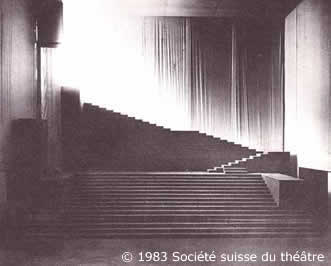 This emblematic light defined Orpheus as the spiritual leader, or elite of his community—as one of the “progressives” who “marched alone, lighting the way,” and whom Jaques-Dalcroze believed the masses necessarily had to follow (Le Rythme 13; original). Emmi Leisner had trained in rhythmic gymnastics for several months before taking on the part of Orpheus; she used her training particularly in this scene, allowing Orpheus to invade the physical space of the furies and shadows in his attempts to tame them. In this hell, the furies confront Orpheus with the vivid specter of his own sexuality, singing and dancing a series of violent movements, choreographed by Jaques-Dalcroze’s student, Anne Beck.33 Audiences were particularly excited to see this famous scene staged as they imagined it may have been in the eighteenth century, before the decline of ballet and dance.34 Jaques-Dalcroze also gave the furies more opportunity in which to move by opening the scene with the “Dance of the Furies,” a number Gluck had originally written for the reform ballet Don Juan (1761), and that he later added to the Parisian version of Orpheus in 1774.35 Jaques-Dalcroze also repeated the furies’ more commonly known dance no. 20 after the chorus no. 23, causing slight dramatic and harmonic confusion, and demonstrating that he was less interested in Orpheus’s ability to overwhelm the furies with his harmonies and vocal sound than in their presentation of a Dionysian sexual threat through plastique animée.
This emblematic light defined Orpheus as the spiritual leader, or elite of his community—as one of the “progressives” who “marched alone, lighting the way,” and whom Jaques-Dalcroze believed the masses necessarily had to follow (Le Rythme 13; original). Emmi Leisner had trained in rhythmic gymnastics for several months before taking on the part of Orpheus; she used her training particularly in this scene, allowing Orpheus to invade the physical space of the furies and shadows in his attempts to tame them. In this hell, the furies confront Orpheus with the vivid specter of his own sexuality, singing and dancing a series of violent movements, choreographed by Jaques-Dalcroze’s student, Anne Beck.33 Audiences were particularly excited to see this famous scene staged as they imagined it may have been in the eighteenth century, before the decline of ballet and dance.34 Jaques-Dalcroze also gave the furies more opportunity in which to move by opening the scene with the “Dance of the Furies,” a number Gluck had originally written for the reform ballet Don Juan (1761), and that he later added to the Parisian version of Orpheus in 1774.35 Jaques-Dalcroze also repeated the furies’ more commonly known dance no. 20 after the chorus no. 23, causing slight dramatic and harmonic confusion, and demonstrating that he was less interested in Orpheus’s ability to overwhelm the furies with his harmonies and vocal sound than in their presentation of a Dionysian sexual threat through plastique animée.
In bringing the furies to life, Jaques-Dalcroze undoubtedly had before him not only Isadora Duncan’s recreation of the “Dance of the Furies” 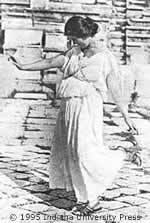 from Gluck’s Orpheus of 1911, but also Wagner’s more famous designs for the Bacchanal in Tannhäuser.36 In the period between Wagner and Jaques-Dalcroze, choruses of angry women (either Bacchanten, Maenades, or Furies), were established as a dominant trope, providing a Dionysian image of the feminine that dialectically opposed the Apollonian grace presented in Act I. Jaques-Dalcroze intensified the threatening allure of these spirits by dividing the furies up into opposing groups of furies and shadows, each of whom wore different costumes and acted independently of each other. The furies sexually provoked not only Orpheus, but also their audiences, by dressing in shocking new maillots resembling modern gymnastic suits and seen in Hellerau publicly for the first time.37 Many members of the audience found it unsettling to see the rapid individual motions of their glistening white limbs and felt overwhelmed by the sea of moving bodies squirming and twisting before them: “it was just a mass of swarming larvae, I don’t know what fantastic image of Gustav Doré or what evocation of Dante,” Ernst Ansermet shuddered (Appia 122; original).
from Gluck’s Orpheus of 1911, but also Wagner’s more famous designs for the Bacchanal in Tannhäuser.36 In the period between Wagner and Jaques-Dalcroze, choruses of angry women (either Bacchanten, Maenades, or Furies), were established as a dominant trope, providing a Dionysian image of the feminine that dialectically opposed the Apollonian grace presented in Act I. Jaques-Dalcroze intensified the threatening allure of these spirits by dividing the furies up into opposing groups of furies and shadows, each of whom wore different costumes and acted independently of each other. The furies sexually provoked not only Orpheus, but also their audiences, by dressing in shocking new maillots resembling modern gymnastic suits and seen in Hellerau publicly for the first time.37 Many members of the audience found it unsettling to see the rapid individual motions of their glistening white limbs and felt overwhelmed by the sea of moving bodies squirming and twisting before them: “it was just a mass of swarming larvae, I don’t know what fantastic image of Gustav Doré or what evocation of Dante,” Ernst Ansermet shuddered (Appia 122; original). 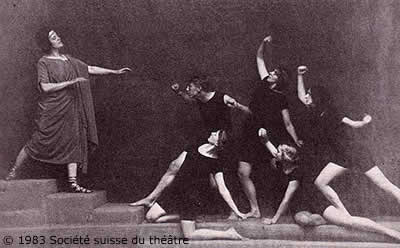 “Imagine,” George Bernard Shaw told a friend, “all the pupils at the school, heaped on the floor in a dim light and tossing their arms and legs about looked like heaps of snakes in hell” (Bernard Shaw 126).38
“Imagine,” George Bernard Shaw told a friend, “all the pupils at the school, heaped on the floor in a dim light and tossing their arms and legs about looked like heaps of snakes in hell” (Bernard Shaw 126).38
The famous dance of the furies from Don Juan offered Jaques-Dalcroze an entirely different rhythmic framework from that of the nymph’s walking lament of Act I. He cut out the mysterious trembling in the first ten measures of Gluck’s score, starting the dance immediately with the powerfully simple progression that begins at m. 11 (Müller 91).39 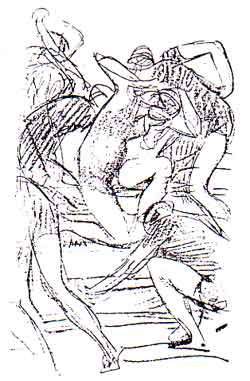 Each chord here receives a four-bar dramatic emphasis and spectacular hammering out on the accented first beat of each bar, giving Annie Beck occasion to have the furies and shadows thrust themselves from one sharp, terrifyingly tense body position into another, designed to match the violence of the downbeats. Hans Brandenburg remembered that “the furies’ intentional, accentuated stamping added a coarsening, impertinent instrument to the music,” and that they unfortunately “stuck too much to the bar line, rather than advancing to the grand, freely controlled line of a rhythmic movement” (Brandenburg 82; original). The tension of the music was so dramatic that even years after Tristan, Jaques-Dalcroze’s audiences practically fell off their seats, each time the rondo dance’s motto dissonance recurred (as in m. 316 where it is a vii/E over a pedal E). (link to listening example 3)
Each chord here receives a four-bar dramatic emphasis and spectacular hammering out on the accented first beat of each bar, giving Annie Beck occasion to have the furies and shadows thrust themselves from one sharp, terrifyingly tense body position into another, designed to match the violence of the downbeats. Hans Brandenburg remembered that “the furies’ intentional, accentuated stamping added a coarsening, impertinent instrument to the music,” and that they unfortunately “stuck too much to the bar line, rather than advancing to the grand, freely controlled line of a rhythmic movement” (Brandenburg 82; original). The tension of the music was so dramatic that even years after Tristan, Jaques-Dalcroze’s audiences practically fell off their seats, each time the rondo dance’s motto dissonance recurred (as in m. 316 where it is a vii/E over a pedal E). (link to listening example 3)
Unlike Wilhelm Jensen’s archaeologist, Orpheus is not awakened by this musical and visual nightmare to the hidden meanings of his archaic Eurydician vision. Rather, he remains in a state of troubling psychological blindness that is significant for Jaques-Dalcroze’s interpretation of the opera. After overcoming the furies through the transcendence of his pure light and sincere song, Orpheus confronts in Elysium not the vibrant young woman Freud found behind the classical relief of Gradiva, but rather Eurydice as a glorious Apollonian presence. Skeptical about the female body’s base urges, Jaques-Dalcroze presented the real Eurydice as even more chaste than Orpheus’s memory of her. This classicized, chaste depiction of Eurydice emphasized Jaques-Dalcroze’s belief that inplastique animée women had to transcend their own corporeality through classicization, relinquish their connection with their sexuality or instinct, and mold themselves aesthetically into art.40 Appia and Jaques-Dalcroze were so convinced of this process that they suggested that their students dance in the nude, because:
… as the idea of sex diminishes in their artistic fever and thanks to the will they have to consecrate themselves entirely to beauty and truth of expression, and as their bodies are penetrated by feeling, so they sense that they would be committing a sin against the spirit by not respecting the nudity of the human body. (Appia 14; original)
Eurydice joins her chorus in expressing a dance of idyllic bliss and sorrow. Although no photographs survive documenting the blessed spirit’s visual appearance and movement style, reviews suggest that this chorus resembled the nymphs of Act I in their dignified gestures and serene music.41 They presented “attitudes couchées,”42 mirroring the rhythmic vitality of Appia’s innovative and visionary stage design by dancing with “imperceptible elevations of their arms,” “inclined heads,” and “slow evolutions” (Ansermet, qtd. in Appia 124). Ernest Ansermet marveled at how perfectly Eurydice realized the music of Gluck’s famous flute solo in dance no. 31 (qtd. in Appia 124). In Berlioz’s opinion, this dance expressed the “sublime lament of a suffering and despairing spirit,” and “eternal grief, still imbued with the passions of earthly life” better than any other in the repertoire (228).
As Orpheus attempts to bring Eurydice to the earth’s surface in the most famous and troubling scene in the opera, she expresses for the first time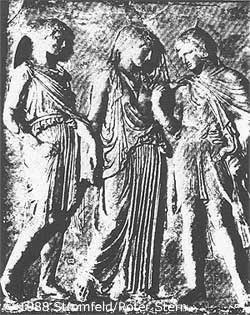 the desires that constitute her subjectivity. He marches proudly to the surface in his music, making no attempt to communicate to her through dance or gesture, although these expressive means have not been forbidden by the gods. Dalcroze emphasized Orpheus’s and Eurydice’s failure to develop mutual trust and rise to the surface as a unified force by adding trumpets, horns, and trombones to the instrumental interludes. This instrumentation gives Orpheus’s march an ominous tone, suggesting that his strict rhythms do not match Eurydice’s lyric dance (Müller 92). Eurydice herself takes on the allure of the timid young woman depicted on a Greek relief, one that Rainer Maria Rilke—a subsequent visitor to Hellerau—described in the poem “Orpheus, Eurydice and Hermes” (written in 1904). Rilke’s Eurydice does not provoke repressed desire through revealing sexual allure, but rather teaches Orpheus through her own Apollonian form about the serene transformation she experienced in the service of musical ideas and through her own human death. The poem’s Eurydice walks again, but this time:
the desires that constitute her subjectivity. He marches proudly to the surface in his music, making no attempt to communicate to her through dance or gesture, although these expressive means have not been forbidden by the gods. Dalcroze emphasized Orpheus’s and Eurydice’s failure to develop mutual trust and rise to the surface as a unified force by adding trumpets, horns, and trombones to the instrumental interludes. This instrumentation gives Orpheus’s march an ominous tone, suggesting that his strict rhythms do not match Eurydice’s lyric dance (Müller 92). Eurydice herself takes on the allure of the timid young woman depicted on a Greek relief, one that Rainer Maria Rilke—a subsequent visitor to Hellerau—described in the poem “Orpheus, Eurydice and Hermes” (written in 1904). Rilke’s Eurydice does not provoke repressed desire through revealing sexual allure, but rather teaches Orpheus through her own Apollonian form about the serene transformation she experienced in the service of musical ideas and through her own human death. The poem’s Eurydice walks again, but this time:
|
… unsicher, sanft und ohne Ungeduld. |
Confused, gentle, and without impatience. |
|
. . . Sie war in einem neuen Mädchentum |
. . . She was inside a new virginity |
|
Sie war schon nicht mehr diese blonde Frau, . . . |
She was no longer that blond woman . . . |
|
Sie war schon Wurzel. Und als plötzlich jäh |
She was already root. And when, all at once, |
(Rilke, Selected Poems 54-5)
Jaques-Dalcroze omits Eurydice’s very human rage aria about leaving Elysium, and proceeds immediately to the moment when Orpheus glances at her. At this point she melts into the curtains as wistfully as she emerged from them, leading the spectators to believe she had been a vision all along, or, as Jaques-Dalcroze commented, “as if it had all been a dream” (Giertz 164; original). Eurydice’s disappearance into the hazy blueness of the plush curtains communicated in the strongest terms that Jaques-Dalcroze’s method was not concerned with the human body and its sexuality, but rather with its transcendence. Her body evaporates into thin air, her energy transformed into the shining glow of the clear bright light that floods the stage, releasing what Jaques-Dalcroze described as energy or “joy,” “a new factor of moral progress, a new stimulant of the human will”—the goal of plastique animée (Le Rythme 59; original). Several years later, Paul Valéry immortalized this neoclassicist vision of dance as transformation in his influential essay “L’âme de la danse.” In his essay, Socrates, Phaedra, and Éryximaque engage in a dialogue over the meaning of dance by watching the Greek dancer, Athikté. This dancer begins by performing Eurydice’s classical Greek walk, “the ankle tipping the body towards the point, the other foot passing and receiving this body, transferring it in advance” (Valéry 13; original). Athikté quickly moves into complex movements, avoiding the “boredom” of reality through the ecstatic impulse of her acting body, which “participates with all her being in the pure and immediate violence of extreme happiness,”— an instant of bodily transcendence in which she resembles a flame (Valéry 26; original). Rainer Maria Rilke expressed a similar vision of the transformative joy of dance when he returned to the figure of Eurydice in his Sonetten an Orpheus, in which he immortalized the recently deceased young dancer Wera Ouckama Knoop:
| Wolle die Wandlung. O sei fur die Flamme begeistert,
drin sich ein Ding dir entzieht, das mit Verwandlungen prunkt; jener entwerfende Geist, welcher das Irdische meistert, liebt in dem Schwung der Figur nichts wie den wendenden Punkt |
Choose to be changed. With the flame, with the flame be enraptured,
where from within you a thing changefully-splendid escapes: nothing whereby that earth-astering artist is captured more than the turning-point touched by his souring shapes. |
(Rilke, Sonnets 111)
In many interpretations of Gluck’s Orpheus, Eurydice’s death, however beautiful, is deemed necessary for Orpheus’s development as a poet and artist. She is the muse whose absence enables Orpheus to create song in his powerfully symbolic air “Che faro senza Eurydice.” Jaques-Dalcroze’s production contested that familiar narrative by having Orpheus collapse exhausted at the end of his aria, leading some of the spectators to conclude that he died without experiencing any psychological or spiritual awakening. By turning around to glance at Eurydice, he demonstrated that he could not live without the vision of her dance, and that he had not learned to be an independent artist, a requirement of plastique animée. Orpheus had neither faced his demons nor transcended the realm of his own artistic activity to become pure light. If that was not enough to shock his audience, Jaques-Dalcroze’s decision to truncate the opera at this point certainly was. Musically knowledgeable spectators argued over the aesthetic merits of omitting Gluck’s disliked yet familiar happy ending in favor of an abrupt return to the opening choral number. This return included a dance by the mourning nymphs, who simply repeated their lament over the loss of Eurydice as they closed the curtains and the performance ended.43 The omission of the famous ballet sequence from the Parisian version of the opera proved unequivocally that this production had not been about dance, but rather about a new art of movement that visualized musical ideas. The nymphs’ return also indicated that plastique animée could only work if Eurydice remained a distant and unattainable vision or idea—the inspiration for Orpheus’s song and the absence that enabled the chorus’s dance. The nymphs reveal that the opera’s central musical idea was Nietzsche’s “elegiac pain of eternal loss” (208); they allowed Jaques-Dalcroze to unify his production by expressing, as he said in his own words, only the tragic core of the Orpheus myth, without its pompous or entertaining elements (Ansermet, qtd. in Appia 124).
Jaques-Dalcroze’s interpretation of Gluck’s famous opera as a tragic depiction of Eurydice’s Apollonian metamorphosis left less than a unified impression on his audiences. Whereas a few writers shared Jaques-Dalcroze’s and Appia’s aesthetic tastes, and reveled in their Orpheus’s classical beauty, many others were wary of the possibility of transcendence or bliss. Gerhart Hauptmann, for example, felt “charmed and shaken by the revelation that beauty still existed in modern bodies, just a bit covered up” (Reudel 17; original). And Paul Claudel exclaimed almost ecstatically that, “it is the first time since ancient Greece that we see true beauty on the stage” (476; original). But many critics felt less emphatic, joked about Jaques-Dalcroze’s project, and wondered about his motives. After all, why were all these young women so diligently following his orders? For Oskar Bie and other eminent critics, the source of such energy was not Apollonian, but rather could only be erotic female energy (366–67). As John Balance explained in the English journal The Mask:
… Apollo never asked for a parade of womanly charms in his service … Women don’t follow after Gods that offer bitterness … No, Venus, or some more pleasant Deity is their favorite. And as Dalcroze fills his school with girls he empties it of Apollonian possibilities and lets the Cyprian slop into the Fold.” (33–4)
In a culture immersed in Nietzsche’s Die Geburt der Tragödie, Jaques-Dalcroze’s classicizing attempt at Greek orchestique appeared as a concession to Apollo—a misdirected emphasis on plasticity, clarity, harmony, light, rational coherence, and a miscomprehension of music’s mythical mystery and Dionysian depths. Some critics even understood Jaques-Dalcroze’s Orpheus nationalistically as an expression of French civilization that had nothing to do with the Dionysian rhythm in the soul of the German people (Marsop 368–69). But perhaps nobody was more suspicious of Jaques-Dalcroze’s project than the Hellerauer workers themselves. The Czech worker Wenzel Holek commented, for example:
One had indeed proclaimed to the whole world that rhythmic gymnastics was an all-purpose medicine that would solve all our social problems. But that still didn’t enable me to suppress my conviction that it may all be nice physical exercise, but nothing more.
The blacksmith was supposed to hammer rhythmically, the locksmith polishes, and the carpenter planes. And peoples’ will was supposed be raised within them. What were people promising themselves from all this, and what was our real work worth in comparison? It was idealistic, unpractical gushing enthusiasm. (128; original)
Holek’s remarks, and the reactions of the community in which he lived, demonstrated how impossible it had become by 1912 to unify German society under the banner of Classicist, humanist principles. Orpheus did not unify, but rather caused dissention and contradiction. Very shortly after the performance of Orpheus in Hellerau, Jaques-Dalcroze had to leave Germany and abandon his school with the outbreak of World War One. Ironically, the spectacular Festspielhaus in Hellerau became not a site of cultural pilgrimage, but rather a field hospital for soldiers, and later, during National Socialism, barracks for the Reichspolizei, SA and SS. After 1945 the Red Army moved in, remaining until the Berlin wall fell in 1989. For almost a century then, daunting violence and the rhythm of guns and marches disrupted Jaques-Dalcroze’s far too innocent aesthetic dream of a beautiful classic walk.
The contradictions of Hellerau were nowhere more evident than in the careers of its dancers. Whereas many of the young gymnasts who danced as furies went on to establish major careers in modern dance (including Mary Wigman, Rosalia Chladek, Bertha von Zoete, Grete Wiesenthaler, and Micho Ito), nothing was later heard of the gymnast who danced Eurydice, and of the nymphs who followed in her footsteps. The violence of the furies, instead of the classicist Eurydice, seemed to resonate in the minds of the young women dancing and of the audience members with feelings they considered central to their own lives and time. Jaques-Dalcroze’s fiercely independent furies left him because they no longer wanted to submit to the rhythms of his chosen music (Suzanne Perrottet 92–93). The fury became so much part of the modern dancer’s image, that some observers stereotypically identified the independence they required for their careers with qualities of anger or madness. When Rudolf von Delius first met Mary Wigman in 1914, he wrote that she was “wild, tall, electric. Almost like a fury” (Odom 51). The desires of these furies, and of the audience members who followed them, could not be met by following in the blissful steps of Eurydice. Such unsettled spectators felt a need for a Freudian exploration of the unconscious, and for a Dionysian conflict that was left unresolved in Jaques-Dalcroze’s Apollonian production—a production that would thus continue to torment and disrupt the entire twentieth–century tradition of neoclassical music visualization.
|
Works Cited Abert, Hermann. “Gluck und unsere Zeit.” Die Musik Gluck-Heft (July 1914): 3–9. —. “Zum Geleit.” Gluck-Jahrbuch 1 (1913): 1–8. Appia, Adolph. Oeuvres complètes. Vol. 3. Ed. and trans. Marie L. Bablet-Hahn. Bonstetten: L’Âge d’Homme, 1988. Arend, Max. “Gluck, der Reformator des Tanzes.” Die Musik 13.19 (July 1913–14): 16–22. Arnold, Klaus-Peter. Vom Sofakissen zum Städtebau: Die Geschichte der Deutschen Werkstätten und der Gartenstadt Hellerau. Dresden: Verlag der Kunst, 1993. Bachmann, Franz. “Jaques-Dalcroze und seine Bestrebungen: Eine Kulturstudie.” Die Musik 2.15 (May 1912): 131–46. Balance, John. “Jacques Dalcroze and his School.” The Mask: A Quarterly Journal of the Art of the Theatre 5 (1912/1913): 33–37. New York, 1967. Barsham, Eve. “Berlioz and Gluck.” C.W. von Gluck: Orfeo. Ed. Patricia Howard. Cambridge: Cambridge UP, 1981. 84–96. —. “Table of Numbers.” C.W. von Gluck: Orfeo. Ed. Patricia Howard. Cambridge: Cambridge UP, 1981. 127–34. Berlioz, Hector. Treatise on Instrumentation. Enlarged and Revised by Richard Strauss. Trans. Theodore Front. New York: Edwin F. Kalmus, 1948. Bernhard Shaw and Mrs. Patrick Campbell: Their Correspondence. Ed. Alan Dent. London: Victor Gollancz Ltd., 1952. Bie, Oskar. Der Tanz. 2nd ed. Berlin: Julius Bard, 1919. Brandenburg, Hans. “Die Bildungsanstalt Jaques-Dalcroze.” Der Moderne Tanz. Munich: Georg Müller, 1913. 55–86. Breuer, Robert. “Hellerau.” Die Schaubühne 8.28/29 (18 July 1912): 50–53. Claudel, Paul. “Le Théatre d’Hellerau.” La nouvelle revue française 10 (1 September 1913). Nedeln: Kraus Reprint, 1968. 474–77. Christoph Willibald Gluck und die Opernreform. Ed. Klaus Hortschansky. Darmstadt: Wissenschaftliche Buchgesellschaft, 1989. 154–71. Csampai, Attila and Dietmar Holland, eds. Claudio Monteverdi: Orfeo/Christoph Willibald Gluck: Orpheus und Eurydike: Texte, Materialien, Kommentare. Reinbek bei Hamburg: Rowohlt, 1988. Daly, Ann. Done Into Dance: Isadora Duncan in America. Bloomington: Indiana UP, 1995. De Michelis, Marco. “Modernity and Reform: Heinrich Tessenow and the Institute Dalcroze at Hellerau.” Perspecta 26 (1990): 143–70. De Zoete, Beryl. The Thunder and the Freshness. New York: Theatre Arts Books, 1963. Dohrn, Wolfgang. Die Gartenstadt Hellerau: Ein Bericht. Jena: Diederichs, 1908. Dutoit-Carlier, Claire-Lise. “Jaques-Dalcroze, Créateur de la Rythmique.” Émile Jaques-Dalcroze: L’homme, le compositeur, le créateur de la rythmique. Ed. Frank Martin. Neuchâtel: A La Baconnière, 1965. 305–412. Edward Muybridge: Motion Studies. (videodisc) Santa Monica, California: Voyager, 1990. —. La danse grecque antique. Paris: Hachette, 1895. Franko, Mark. Dancing Modernism/Performing Politics. Bloomington: Indiana UP, 1995. Frecot, Janos. “Die Lebensreformbewegung.” Das Wilhelminische Bildungsburgertum. Ed. Klaus Vondung. Göttingen: Vandenhoek & Ruprecht, 1976. 138–52. Freud, Sigmund. “Der Wahn und die Träume in W. Jensen’s Gradiva (1907).” Studienausgabe X: Bildende Kunst und Literatur. Frankfurt am Main: Fischer, 1969. 9–86. Giertz, Gernot. Kultus ohne Götter: Emile Jaques-Dalcroze und Adolphe Appia: Der Versuch einer Theaterreform auf der Grundlage der Rhythmischen Gymnastik. Münich: Kommissionsverlag J. Kitzinger, 1975. Gluck, Christoph Willibald. “Orfeo ed Euridice.” Denkmäler der Tonkunst in Österreich. Ed. Hermann Abert. Series 2. Vol. 44a. Vienna, 1914. Graz: Akademischer Druck- und Verlagsanstalt, 1960. “Gluck Orphée.” Avant Scène (September–October 1979): 72–95. Holek, Wenzel. Vom Handarbeiter zum Jugenderzeiher: Lebensgang eines deutsch-tschechischen Handarbeiters. 2 Vols. Jena: Diederichs, 1921. Horneffer, August. “Das Fest.” Die Schulfeste der Bildungsanstalt Jaques-Dalcroze: Programmbuch. Ed. Bildungsanstalt Jaques-Dalcroze. Der Rhythmus: Ein Jahrbuch 2.1 (1912): 14–20. Howard, Patricia. C.W. von Gluck: Orfeo. Cambridge: Cambridge UP, 1981. Isadora Duncan: Movement from the Soul. Produced and directed by Dayna Goldfine and Daniel Geller. Los Angeles: Direct Cinema Limited, 1989. Janet, Pierre. L’automatisme psychologiqe: essai de psychologie expérimentale sur les formes inférieures de l’activité humaine. Paris: F. Alcan, 1889. Jaques-Dalcroze, Emile. Le Rythme, la Musique et l’Éducation. Lausanne: Foetische Frères, 1965. —. Méthode. Paris: Sandoz, 1906. Kaufmann, Harald. “Orpheus zwischen Form und Ausdruck: Beobachtungen bei Christoph Willibald Gluck.” Österreichische Musikzeitschrift 19 (1964): 409–21. Keller, Otto. “Gluck-Bibliographie.” Die Musik Gluck-Heft (July 1914): 23–37 and 83–91. Koritz, Amy. Gendering Bodies/Performing Art: Dance and Literature in Early Twentieth–Century British Culture. Ann Arbor: University of Michigan Press, 1995. Krieger, Michael. “Orpheus mit Glück: The Deceiving Gratifications of Presence.” Theatre Journal 35.3 (October 1983): 295–306. Lorenz, Karl. Wege nach Hellerau: auf den Spuren der Rhythmik. Dresden: Hellerau-Verlag, 1994. Marey, Etienne-Jules. La machine animale: locomation terrestre et aérienne. 4th ed. Paris: F. Alcan, 1886. —. Le mouvement. Arles: Diffusion Harmonia Mundi, 1994. Marsop, Paul. “Jaques-Dalcroze, Hellerau und die Musik.” Neue Kämpfe: Zweite Reihe der Studienblätter eines Musikers. Munich: Georg Müller, 1913. 362–96. Martin, Frank, ed. Émile Jaques-Dalcroze: L’homme, le compositeur, le créateur de la rythmique. Neuchâtel: A La Baconnière, 1965. Müller, Erich H. “Notizen.” Gluck-Jahrbuch 1 (1913): 91–92. Muybridge, Edward. Animal Locomotion: An Electro-Photographic Investigation of Consecutive Phases of Animal Movements, 1872–1885.Philadelphia: University of Pennsylvania, 1887. —. The Human Figure in Motion: An Electro-Photographic Investigation of Consecutive Phases of Muscular Actions. London: Chapman & Hall, 1901. —. Muybridge’s Complete Human and Animal Locomotion: All 781 Plates from the 1887 Animal Locomotion. New York: Dover, 1979. Niedecken-Gebhard, Hanns. “Chr. W. Gluck’s ‘Orfeo’ bei den Festspielen im Lauchstedter Goethetheater.” Zeitschrift der Internationalen Musik-Gesellschaft 15.10/11 (July–August 1914): 296–97. Nietzsche, Friedrich. Die Geburt der Tragödie: Schriften zu Literature und Philosophie der Griechen. Ed. Manfred Landfester. Frankfurt am Main: Insel, 1994. Odom, Selma Landen. “Wigman at Hellerau.” Ballet Review 14.2 (Summer 1986): 41–53. “‘Orpheus’ auf der Elbinger Waldbühne.” Neue Musik-Zeitung 35.22 (1914): 438. Reudel, Elfriede. Rhythmik: Theorie und Praxis der körperliche-musikalischen Erziehung. Münich: Delphine, 1926. Riesenfeld, Paul. “Die Schulfeste in Dresden-Hellerau: Mit einer Einleitung in die Philosophie der Tanzkunst.” Neue Musik-Zeitung 33.23 (1912): 471–76. Rilke, Rainer Maria. Selected Poems of Rainer Maria Rilke. Trans. David Young. Oberlin: Oberlin College, 1994. —. Sonnets to Orpheus. Trans. J.B. Leishman. London: Hogarth, 1946. —. Werke. Ed. Rilke-Archiv. Frankfurt a. M.: Insel, 1982. Ruyter, Nancy Lee Chalfa. The Cultivation of Body and Mind in Nineteenth-Century American Delsartism. Westport, Conn.: Greenwood Press, 1999. Salzman, Alexander von. “Licht, Belichtung und Beleuchtung; Bemerkungen zur Beleuchtungsanlage des grossen Saales der Dalcroze-Schule.” Die Schulfeste der Bildungsanstalt Jaques-Dalcroze: Programmbuch. Ed. Bildungsanstalt Jaques-Dalcroze. Der Rhythmus: Ein Jahrbuch 1.1 (1912): 69–72. Die Schulfeste der Bildungsanstalt Jaques-Dalcroze: Programmbuch. Ed. Bildungsanstalt Jaques-Dalcroze. Der Rhythmus: Ein Jahrbuch 2.1 (1912). Seidl, Arthur. Die Hellerauer Schulfeste und die Bildungsanstalt Jaques-Dalcroze. Vol. 2 of Deutsche Musikbücherei. Regensburg: Gustav Bosse, 1912. Shawn, Ted. Every Little Movement: A Book about François Delsarte. 2nd ed. New York: Dance Horizons, Inc., 1963. Sinclair, Upton. World’s End. New York: The Literary Guild of America, Inc., 1940. Stadler, Edmond. “Jaques-Dalcroze et Adolphe Appia.” Émile Jaques-Dalcroze: L’homme, le compositeur, le créateur de la rythmique. Ed. Frank Martin. Neuchâtel: A La Baconnière, 1965. 413–60. Storck, Karl. “Das Programm.” Die Schulfeste der Bildungsanstalt Jaques-Dalcroze: Programmbuch. Ed. Bildungsanstalt Jaques-Dalcroze. Der Rhythmus: Ein Jahrbuch 1.1 (1912): 21–39. Suzanne Perrottet: Ein Bewegtes Leben. Ed. Giorgio J. Wolfensberger. Bern: Benteli Verlag, 1989. Theweleit, Klaus. Buch der Könige, vol. 1, Orpheus Valéry, Paul. “L’ame de la danse.” La revue musicale (December 1921): 3–32. Volbach, Walther R. Adolphe Appia: Prophet of the Modern Theatre. A Profile. Middletown: Wesleyan UP, 1968. |
- The description of Hellerau which opens Upton Sinclair’s novel, World’s End, is partly fictional and should not be taken as historical evidence. Sinclair claims that the opera began with the overture and ended with the blissful reunion of Orpheus and Eurydice, for example. These are literary details invented by Sinclair for the purposes of his novel. ↩
- Bie, like other critics, did not seem to recognize this as a yin-yang symbol. Instead, he described it as “an S in a circle” (“eine S-Linie im Kreis”). See also Seidl 28. ↩
- The supporters of the Hellerau project frequently compared Jaques-Dalcroze’s Bildungsanstalt to the pedagogical province from Goethe’s Wilhelm Meisters Wanderjahre. See Die Schulfeste der Bildungsanstalt Jaques-Dalcroze, title page; Seidl 12, 15, 23; and Marsop 363. Seidl commented that this symbol embodied the Hellerau project and could be seen from very far away (29). It is important to note that Jaques-Dalcroze’s production of Gluck’s Orpheus und Eurydice took place at dusk. Seidl comments on how inconvenient he found the 7:00 pm starting time in comparison with the 4:00 pm scheduling of operatic performances at Bayreuth (31). ↩
- For a description of the building as “naked” see Engel in the Berliner Tageblatt, 3 June 1912 (Appia 103). ↩
- The main hall was 49 meters long, 16 meters wide, and twelve meters high, creating an unusual rectangular space that critics frequently mentioned in their reviews. The bare walls had been draped in a white cloth, over which were set 3,000 blue, green and white light bulbs at equal intervals. A second wax-drenched white cloth had been hung one meter over the lightbulbs in order to diffuse the glow of light. Capable of alternating in patterns of blue, green, and white and creating crescendos and diminuendos, the strength and color of the lightbulbs were set in motion by the engineer Harald Dohrn, who handled a light console with 47 circuits behind the scenes and also controlled the mobile screens on the ceiling which could be lowered to allow light to pass from projectors that acted as spotlights. The light system cost 70,000 Marks and was installed by Siemens-Schuckert, as many critics commented. It had been invented by Alexandre von Salzman, inspired by Jaques-Dalcroze and Adolph Appia, and influenced by Rudolf Steiner. This description of the light is provided in Appia 103–11. ↩
- Paul Bekker, review in the Frankfurter Zeitung, 21 June 1912, translated into French by Marie L. Bablet-Hahn in Appia 207. Salzman wrote that “instead of lighted space, we have a light-producing space. Light is conveyed through the space itself, and the diversion of visible light sources is done away with.” (“So haben wir statt eines belichteten Raumes einen leuchtenden Raum. Das Licht ist in den Raum selbst übertragen, und das Ablenkende der sichtbaren Lichtquelle fällt weg”) (70). ↩
- The crowd included, at different times, Ernest Bloch, Paul Claudel, Serge Diaghilev, Harley Granville-Barker, Hugo von Hofmannsthal, Hanya Holm, Percy Ingham, Kurt Jooss, Rudolf von Laban, Le Corbusier, Emil Nolde, Anna Pavlova, Serge Rachmaninoff, Max Reinhardt, Alfred Roller, George Bernhard Shaw, Upton Sinclair, Constantin Stanislavski, and Prince Serge Volkonski. ↩
- Most of these plans never materialized, due to the financial bankruptcy faced by the Hellerau project after 1914. See Arnold 350. ↩
- Riemerschmidt was not the only architect to work in Hellerau, however. Over the years the style of its buildings did not remain unified. ↩
- In their desire to transform human beings by providing them with the proper surrounding, training, and culture, the developers of the Hellerau project showed their allegiance to the ideals of the ambiguous movement known as the “Reform of Life.” See De Michelis 149; and Frecot 138–52. ↩
- Classes in harmony and choral singing were taught by Ernst Lendvai. See De Zoete 23. ↩
- See Gluck, Orfeo ed Euridice. Gluck’s Orpheus was performed around this time, for example, in Chemnitz (1913), Dresden, Frankfurt (1913), Hellerau (1913), Lauchstedt (1913), London (1905), Mézières (1911), Milan (1907), Munich (1909), New York (1906,10,12), Orange (1911), and Paris (1905, 07, 08, 12, 13). For lists of performances of Gluck’s works in Germany in the first fourteen years of the twentieth century, see Keller. Abert comments on the lack of attention given to Gluck in Germany at the time of the founding of the Gluck Gesellschaft in “Zum Geleit” 1. In a later article, Abert writes that Gluck is no longer “alive: the masses relate to him as Faust would to the bible: they admire him, but without any desire. For many people, not only amateurs but also musicians, Gluck is a long forgotten great.” (“lebendig: Die grosse Masse stellt sich zu ihm, wie etwa Faust zu den Sakramenten: sie ehrt ihn, doch ohne Verlangen; für viele, und zwar nicht allein unter den Laien, sondern auch unter den Musikern, ist er eine längst abgetane Größe”) (Abert, “Gluck” 1). See also “Gluck Orphée.” ↩
- Arend argues that Gluck’s dance compositions interrelated in important ways with developments in dance in his own day, their resonances being felt in Richard Strauss’s Josephslegende, the events at Hellerau, and the dances of Isadora Duncan (17). Arend published the libretto to Gluck’s Don Juan in the Neue Zeitschrift für Musik (1905): 12–14. ↩
- Storck and others defined Beethoven’s music as most inappropriate for realization in dance (30). Isadora Duncan received harsh criticism for her use of Beethoven’s Symphony No. 7 in 1908 and again in 1909, with Walter Damrosch and the New York Sympony Orchestra (Daly 143). Compare, as well, the comments on Beethoven, Wagner, program music, and Jaques-Dalcroze’s project in Hellerau in Bachmann 139–144; and Brandenburg 74–76. Brandenburg rejects Storck’s and others’ distinction between “tönend bewegte Formen” and Ausdrucksmusik, concluding that the best music for dance is that which contains “movement impulses” (Bewegungsimpulse). ↩
- Berlioz not only enriched Gluck’s orchestra through an informed analysis of the original scores, but also rewritten Orpheus’s part for a mezzo-soprano (Pauline Viardot-Garcia), establishing a tradition that survived in Germany until Fall 1913. See Barsham’s “Berlioz and Gluck.” Barsham gives a table comparing Berlioz’s with Gluck’s Viennese and Parisian versions of the opera on pages 127–34 of the same volume. ↩
- Jaques-Dalcroze wrote a series of letters to Appia after the performances in Mézières and St. Petersburg, expressing his dissatisfaction with them. In an undated letter to Appia, he writes that the staging in Mézières “resulted from a pictoral fantasy, and never, not for a single moment, from the music” (“Une mise en scène improvisée issue d’une fantaisie picturale, mais ne découlant pas de la musique, à aucun moment”) (qtd. in Stadler 440). ↩
- When the second act of Orpheus was performed in Hellerau in 1912, a stage curtain was not present. It was added, however, in 1913. Adolph Appia strongly disapproved of the use of this curtain, because it distinguished between the performers and spectators in a manner he found old-fashioned (Volbach 87–92). There is very little information on the orchestration Jaques-Dalcroze used for his production of Gluck’s Orpheus. We do know, however, that the orchestra was sunken and invisible, and that the instruments had been arranged in an unusual fashion to accentuate their individual colors. See Riesenfeld 472. ↩
- Description given by Richard Vesely, in Hudebni Revue (Prague) 6 (1912–13): 573–75; translated into French in Appia 215. See also Auguste de Morsier’s review from the Journal de Genève (30 June 1913) in Appia 218. H.C. Bonifas notes in his review in La Semaine littéraire (Geneva, 26 July 1913) that the overture was omitted (Appia 222). It was common to use a female alto for the part of Orpheus in Germany at this time, although the much talked about staging in Lauchstadt in November 1913 used a baritone as noted above. See “’Orpheus’ auf der Elbinger Waldbühne.” ↩
- Although Jaques-Dalcroze admired Isadora Duncan’s revolutionary desire to revive Greek dance, he felt that she did not understand or respond adequately to the music. See Dutoit-Carlier 351–52. ↩
- A comparison of Jaques-Dalcroze’s movement practice with recent recorded performances of Gluck’s Orpheus demonstrates how innovative and musical his approach was. In the Glyndebourne Festival Opera production of Orpheus, the dancers walk rhythmically against the music in both this scene and the “Dance of the Blessed Spirits,” demonstrating not a dramatic intention, but rather a lack of feeling for the music they are singing. ↩
- Jaques-Dalcroze’s writings quote most frequently not from late nineteenth–century philosophy, but rather from classical French eighteenth–century writers like Diderot, Montaigne, La Rochefoucauld, Rousseau, and Fenélon. Nevertheless, German critics tended to link his plastique animée to Nietzsche’s philosophy. See Riesenfeld. In his study on Hellerau, Seidl rooted Jaques-Dalcroze’s plastique animée in a German aesthetic tradition beginning with Lessing’s Laokoon, and developing through Herder’s “Von der Grazie,” Schiller’s “Bühne als moralische Bildungsanstalt” and Briefe über ästhetische Erziehung, Goethe’s Wilhelm Meisters Wanderjahre, Heinrich von Kleist’s “Gespräch über das Marionetten-Theater,” Wagner’s Das Kunstwerk der Zukunft, Gottfried Keller’s “Am Mythenstein,” Nietzsche’s Unzeitgemäße Betrachtungen, Hans von Bülow’s “III. Deutschen Kunsterziehungstag,” and Karl Bucher’s Arbeit und Rhythmus. Many of these sources are cited frequently throughout the literature on Hellerau. ↩
- Jaques-Dalcroze used and studied primarily music by Chopin, Berlioz, and Liszt in his classes on rhythmic gymnastics. He made a particular point of buying all his students copies of Beethoven’s Symphony No. 7, so that they could study the dance rhythms (See Suzanne Perrottet 48, 53, 54; and Martin 324). Like many of his contemporaries, Jaques-Dalcroze also admired Richard Strauss’s music because of its potential for modern dance. After seeing the closing dance of Strauss’s Elektra in Munich in 1909, Jaques-Dalcroze exclaimed “[Elektra ↩
- Jaques-Dalcroze comments on rubato in “Le Rhythme au Théâtre,” La Grande Revue (Paris) (10 June 1910): 539–50 (qtd. in Appia 12). The recording you hear here of Emmy Leisner was made over a decade after her performance at Hellerau. I was not able to find any indication of how she performed the work there. ↩
- Many modern dancers would embrace the notion that irregular meters were more suitable to visual realization in dance. ↩
- Perhaps for this reason, Jaques-Dalcroze found this first act easiest to stage (letter to Appia, 11 February 1913, qtd. in Stadler 446.) Richard Wagner also felt that this act best represented “the complete harmony of music and image.” (“die vollkommene Harmonie der Musik und des Bildes.”) (Richard Wagner in a comment to the ballet master Fricke, quoted by Marsop, “Die Hellerauer Feste und ihr Programm,” in Die Schulfeste der Bildungsanstalt Jaques-Dalcroze: Programm 43). ↩
- Shawn describes “statue posing” as falsification of the “science which Delsarte taught” (11). ↩
- Jaques-Dalcroze owned Angélique Arnaud, François Del Sarte, ses découvertes en esthétique, sa science, sa méthode (Paris: A. Giraudet, 1895); and François Del Sarte, Physionomie et gestes (see Appia 28). Jaques-Dalcroze criticized Isadora Duncan’s students for adopting such poses from Greek statues, thereby neglecting spontaneous, “sincere” feelings of the music (qtd. from unnamed source in Dutoit-Carlier 352). Jaques-Dalcroze’s supporters likewise linked his approach to bodily movement back to Del Sarte, rejecting Isadora Duncan’s work as inadequate to the music. See Storck 28–29. ↩
- It is interesting to contemplate the correspondence between Jaques-Dalcroze’s and Appia’s understanding of space and Edmund Husserl’s definition of objectivized space in Ding und Raum. Rudolf Laban radically revised this approach by centering spatial motion subjectively in the individual in the theories of Choreographie that he developed in the 1920s. ↩
- Weber-Bauler’s study on Jaques-Dalcroze is quoted in Dutoit-Carlier 337–8. No source for the study is given. ↩
- Jaques-Dalcroze, comments from an unnamed sources in Dutoit-Carlier 321. Dutoit-Carlier cites the later work of Adolphe Ferrière as important to understanding this notion of “detente.” ↩
- The use of blue light in the first scene is documented by Richard Vesely, in Hudebni Revue VI, translated into French in Appia 215. ↩
- Seidl commented on how distressing he found the absence of Orpheus’s lyre (36–7). ↩
- This was the only scene in the opera in which Jaques-Dalcroze’s students sang and danced at the same time. ↩
- Arend comments that the furies were world famous “in spite of their normally dreadful representation” (“trotz ihrer üblichen jämmerlichen Darstellung”). He describes how Wagner omitted the dance sequences in his productions of Gluck because of his dissatisfaction with the quality of the Dresden ballet. See Arend 16; and Marsop 378. ↩
- Berlioz had kept the “Dance of the Furies” at the end of this act in his version of the opera from 1866. See Barsham, “Table of Numbers” 129. The dance rarely opened the act in any of the existing hybrid versions of the opera, however. ↩
- Isadora Duncan’s “Dance of the Furies” (1911) is recreated on the video Isadora Duncan: Movement from the Soul. ↩
-
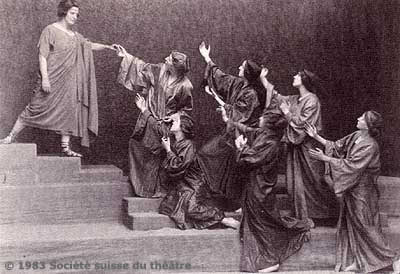 Adolphe Appia was the guiding influenced in the choice of costumes for this scene. Jaques-Dalcroze had been using marine blue gym suits since 1908. Adolphe Appia fought bitterly with the actual designer, the doctor Léon Weber-Bauler, over the costumes for the furies, and left Hellerau in a fit of rage. He was so distraught at the thought of the furies wearing anything fancy or colorful instead of plain blue gym suits that he was supposedly sick for eight days and cried more than he ever had in his life. In 1922, he commented to his doctor that he had wanted the furies to perform nude, and had thus resisted any attempts to give them costumes resembling clothes (Appia 111–14). There was much dispute about whether the gym suits were blue, black, or grey. In his writings on the subject, Appia favored grey as a color that could best absorb and reflect light. See “Du costume pour la gymnastique rythmique,” in Appia 160. ↩
Adolphe Appia was the guiding influenced in the choice of costumes for this scene. Jaques-Dalcroze had been using marine blue gym suits since 1908. Adolphe Appia fought bitterly with the actual designer, the doctor Léon Weber-Bauler, over the costumes for the furies, and left Hellerau in a fit of rage. He was so distraught at the thought of the furies wearing anything fancy or colorful instead of plain blue gym suits that he was supposedly sick for eight days and cried more than he ever had in his life. In 1922, he commented to his doctor that he had wanted the furies to perform nude, and had thus resisted any attempts to give them costumes resembling clothes (Appia 111–14). There was much dispute about whether the gym suits were blue, black, or grey. In his writings on the subject, Appia favored grey as a color that could best absorb and reflect light. See “Du costume pour la gymnastique rythmique,” in Appia 160. ↩ - Not everybody was terrified by Annie Beck’s choreographic vision. Robert Breuer, for example, found this scene “kitsch,” exuding all the “sweet romanticism” of Bartholomé’s frescos of death. He also criticized Jaques-Dalcroze for visualizing the music in a manner that suppressed the singers’ individuality in favor of choral, mass effects. See Breuer 51–52. ↩
- Müller gives the most detailed account of the changes Jaques-Dalcroze made to Gluck’s score. He departs from the premise that Jaques-Dalcroze’s set as his basis a “Peters Edition” of the opera. I assume he is referring to Christoph Willibald Gluck, Orpheus: Oper in 3 Akten, Klavierauszug nach der französischen Partitur, transcribed by Alfred Dörffel (Leipzig: C.F. Peters, no date). ↩
- Koritz discusses how Isadora Duncan similarily convinced critics of the seriousness of her art by classicizing it, thereby diverting their attention away from her body as an object of desire (31–56). ↩
- Ernest Ansermet, in Gazette de Lausanne, 3 July 1913, quoted in Appia 124. Ansermet comments that the blessed spirits’ serenity was not matched by the music, which was poorly performed. ↩
- Jaques-Dalcroze, letter to Adolphe Appia, 20 December 1912, quoted in Stadler 446. ↩
- Wieland Wagner solved the problem of the third act of Gluck’s Orpheus in exactly the same manner in his more well-known production of the work in Bayreuth in the 1950s. It seems likely that Wagner would have known of or heard about Dalcroze’s earlier production. ↩
